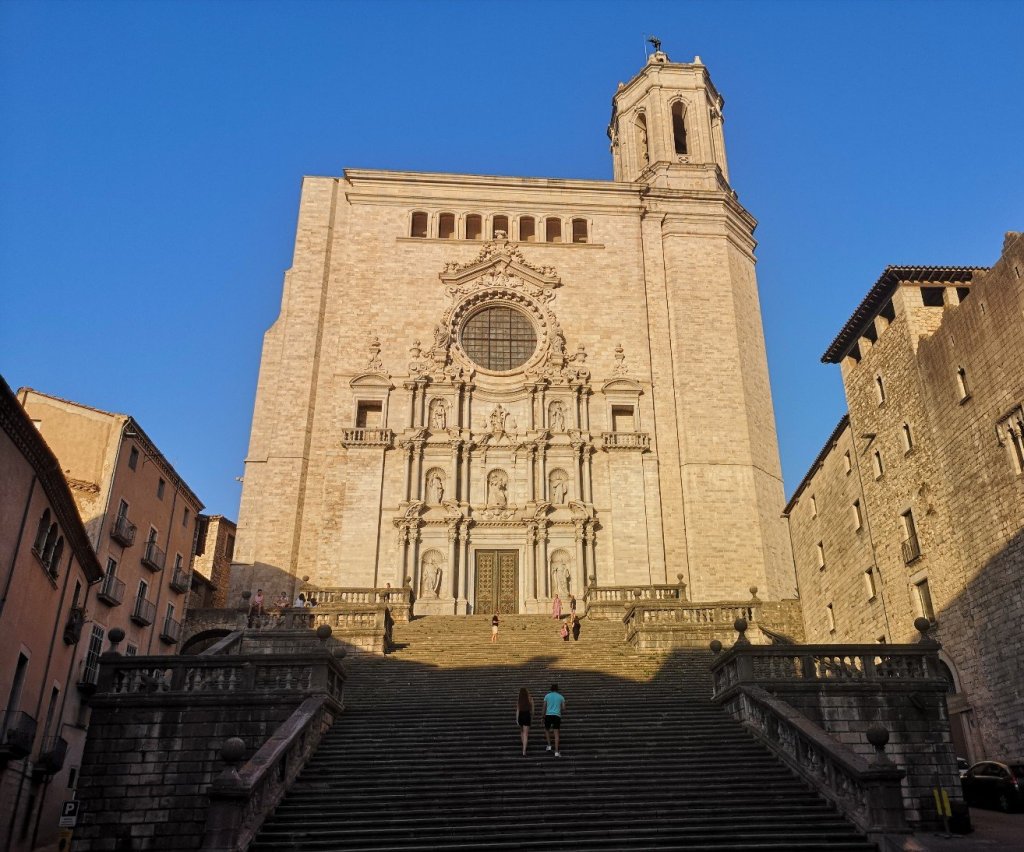This was the first of three mini-pilgrimages offered to delegates of the international meeting ‘Walking Art and Relational Geographies’ and others in Girona, Cataluña. 6 July 2022
We met at the foot of the steps of the Catedral de Girona, a traditional location for the start of a pilgrimage. As we waited for the group to assemble, I asked, do you see any pilgrim signs?

The statues at the front of the building are inset with the shell motif behind them – the iconic scallop being the emblem which pilgrims on their way to Santiago de Compostela sported.

We searched for the yellow arrows which are used to indicate the path; instead we were surrounded by the yellow ribboned loops of the Cataluñan Independence movement.

We were a group of approximately twelve, and I explained that I had changed the place we were walking to once I knew the start time was 9pm (sunset is around 9.20 here), and now that the city and I had started to get acquainted in person, rather than virtually from Scotland in the initial planning stages.

The title of my walking project here is Separation and Unity, being aware of the political issues that concern Scotland and Cataluña, both, in their debates and attempts at achieving autonomy from England and Spain respectively.
We performed some simple experiential exercises: huddling close, noting that we were united in our interest in walking, turning outwards to acknowledge those people around us who were not in our group or who were in groups of their own.
We began some chi gung exercises, a method of grounding and centering in the body. It became clear that we needed to take more space for ourselves in order to move individually. We were moving together, separately and experimenting with breathing in unison.

Last week, I walked part of the Cami Sant Jaume alone, as a secular pilgrimage.
I was on the path with others – dog walkers, cyclists, 2 hikers. Walking part of this age-old tradition, I knew there were others who went before me and who will come after.
Now our group traced a pilgrim path through the archway made by the city walls and, despite there being no external signs to guide us, we headed downhill to the river. We left the heavy, archetypal building behind and walked in silence, in single-file, with the thick, steep walls with religious iconography on either side.

As we walked down Reí Marti, we paid attention to our connection with the elements – the paved surfaces under our feet, the air and water – indivisible.
Also to the birds we could hear but not always see, the insects we only knew were there if we looked very carefully or when they bit us, the other folk milling around the city. We were a mass moving inside and outside the city walls.
We were aware of each other walking together. Our intention was clear.

As the streets opened out, we turned left taking Carrer del Bellaire and heading straight for the river, passing once again,
underneath, though by now we were amongst modern architectural constructs. The train line ran overhead.

Around the cornerstone the left, was the Column of the History of Girona, a pillar of stone whose four sides depicted images and text saying this ancient settlement back to the Neolithic.

We were at the River Onyar and the Pont (bridge) de Pedret which formed a crossroads where the first Cami de Sant Jaume and other route signs were located.




We glimpsed the La Devesa Park where we walked yesterday.
As I walked out of Girona, I moved from the urban environment, the edge lands where people were growing crops in their hueltas / allotments, and then out of town, walking between city and towns. There were people stringing these urban places together by walking between them to work and school.
I was carrying my clothes and sleeping mat with me, crossing the country, from Osona to La Garrotxa and into the Barcelona región.
We completed our mini-pilgrimage at the foot of the steps of Basílica de Sant Feliu, a familiar way to end a pilgrimage. Close by is the statue of la Lleona (lioness) whose bottom/ass you are invited to kiss, an 11th century folk tradition.


Soundscape by Ralph Hoyte Temple of Hermes

This brings back memories of a lovely time we spent in Girona and walking part of the pilgrimage route several years ago. Personally I think you have handled the similarity and differences between Scotland and Cataluna’s search for independence with sensitivity.
LikeLike
Thank you Liza, I would love to compare notes with you
LikeLiked by 1 person
I can’t say I’m in sympathy with a trip based on interfering with another country’s politics.
Cynthia
Get Outlook for Androidhttps://aka.ms/AAb9ysg ________________________________
LikeLike
Hi Cynthia, Thank you for your comment. My trip is an acknowledgment and enquiry of the struggle between the forces of separation and unity. It doesn’t make any decisions or statements, certainly does not ‘interfere’ but walks with the energy which is generated when people feel they want their identity recognised and ideally remain part of the whole. Th binary energies of ‘be one’ vs ‘be separate’ have become polarised and my walk seeks to listen to both ‘sides’ and, more importantly, the grey areas inbetween.
LikeLike